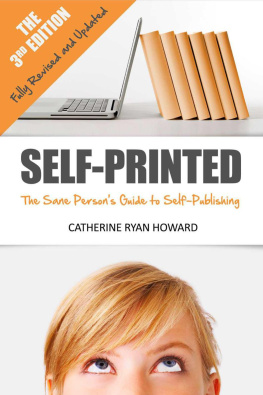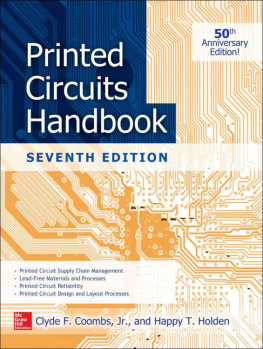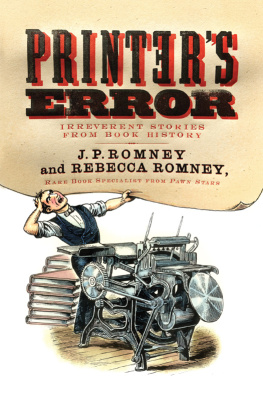2010 The University of North Carolina Press
All rights reserved
Manufactured in the United States of America
Designed and set in Adobe Caslon Pro and Monticello by Rebecca Evans
The paper in this book meets the guidelines for permanence and durability of the Committee on Production Guidelines for Book Longevity of the Council on Library Resources.
The University of North Carolina Press has been a member of the Green Press Initiative since 2003.
Library of Congress Cataloging-in-Publication Data
Round, Phillip H., 1958
Removable type: histories of the book in Indian
country, 16631880 / Phillip H. Round.
p. cm. Includes bibliographical references and index.
ISBN 978-0-8078-3390-2 (alk. paper)ISBN 978-0-8078-7120-1 (pbk.: alk. paper)
1. Indians of North AmericaBooks and reading. 2. Books and readingUnited States
History. 3. Indians of North AmericaGovernment relations. 4. LiteracySocial
aspectsUnited States. 5. Indians of North AmericaCultural assimilation. I. Title.
E98.B65R68 2010 028.08997073dc22 2010006644
cloth 14 13 12 11 10 5 4 3 2 1
paper 14 13 12 11 10 5 4 3 2 1
An earlier version of chapter 8 appeared as Indigenous Illustration: Native American Artists and Nineteenth-Century U.S. Print Culture, American Literary History 19, no. 2 (2007): 26789; reprinted by permission of Oxford University Press.
Excerpts from Delphine Red Shirt, Bead on an Anthill: A Lakota Childhood, 1998 The University of Nebraska Press, are reprinted by permission of the University of Nebraska Press.
Excerpts from Ray A. Young Bear, Black Eagle Child, are reprinted by permission of the University of Iowa Press.
Contents
Introduction
Toward an Indian Bibliography
Chapter One
The Coming of the Book to Indian Country
Chapter Two
Being and Becoming Literate in the Eighteenth-Century Native Northeast
Chapter Three
New and Uncommon Means
Chapter Four
Public Writing I: To Feel Interest in Our Welfare
Chapter Five
Public Writing II: The Cherokee, a Reading and Intellectual People
Chapter Six
Proprietary Authorship
Chapter Seven
The Culture of Reprinting
Chapter Eight
Indigenous Illustration
Epilogue
The View from Red Cloud's Grave
Illustrations
1 Pablo Tac, Luiseo Dancers, in his Conversin de los Luiseos de Alta California (ca. 183841)
2 Tablet Containing 21 Drawings by Samson Kelly (Cheyenne), and Carl Sweezy (Arapaho) (ca. 1904)
3 Battiste Good, Brul Winter Count (ca. 1880)
4 Theodore DeBry, The Marks of Sundry of the Chief Men, in Thomas Harriot, A Brief and True Report of the New Found Land of Virginia (1590)
5 Seal of the Society for the Propagation of the Gospel
6 Title page of Mamusse wunneetupanatamwe up biblum God (1685)
7 Table of contents of Mamusse wunneetupanatamwe up biblum God (1663)
8 Annotated page from Mamusse wunneetupanatamwe up biblum God (1663)
9 Title pages of John Eliot, Wehkomaonganoo (1664), and Richard Baxter, A Call to the Unconverted (1652)
10 Page from John Eliot, Wehkomaonganoo (1664)
11 Page from John Eliot, The Indian Primer (1720)
12 Masthead of The Mental Elevator (1841)
13 Samples of Native student handwriting collected by Eleazar Wheelock (1772)
14 Title page of Samson Occom, A Sermon, Preached at the Execution of Moses Paul (1772)
15 Massachusetts Sabbath School Society, Bible verse card
16 Title page of Jabez Hyde, Indian Hymns (1818)
17 Dennis Cusick, Seneca Mission School (1821)
18 Eleazar Williams, Haudenosaunee-language religious tract (ca. 1820s)
19 Page from Church of England, Portions of the Book of Common Prayer in Cree (1856)
20 Page from Hendrick Aupaumut, Journal of a Mission to the Western Tribes of Indians (1791)
21 Front page of the Cherokee Phoenix, March 6, 1828
22 Inali (Black Fox), Cherokee syllabary formula
23 Frontispiece of William Apess, A Son of the Forest (1831)
24 Frontispiece of George Copway, Life, History, and Travels (1847)
25 Frontispiece of Black Hawk, Life of Ma-ka-tai-me-she-kia-kiak, or Black Hawk (1836)
26 Title page of Samson Occom, Sermon, Preached at the Execution of Moses Paul (1810)
27 Frontispiece of Black Hawk, Life of Ma-ka-tai-me-she-kia-kiak, or Black Hawk (1834)
28 Cover and frontispiece of Elias Johnson, Legends, Traditions, and Laws of the Iroquois or Six Nations and History of the Tuscarora Indians (1881)
29. Prayer after Reading, in Abraham Luckenbach, Forty-six Select Scripture Narratives from the Old Testament (1848)
30 The Bed Room of American Horse (1891)
31 Page from Samuel Penhallow, History of the Wars of New England with the Eastern Indians (1726)
32 Ojibwe Petition, in Henry Rowe Schoolcraft, Historical and Statistical Information (185157)
33 Alfred R. Waud, title page, Word Carrier (January 1875)
34 Cover detail, Henry Rowe Schoolcraft, Historical and Statistical Information (185157)
35 David Cusick, The Flying Head Put to Flight by a Woman Parching Acorns, in David Cusick's Sketches of Ancient History of the Six Nations (1848)
36 David Cusick, Atotarho, a Famous War Chief, Resided at Onondaga, in David Cusick's Sketches of Ancient History of the Six Nations (1848)
37 Seth Eastman, Atotarho, in Henry Rowe Schoolcraft, Historical and Statistical Information (185157)
38 Silver Horn, Saynday Escapes from Sapoul, in Target Record Book (1890s)










